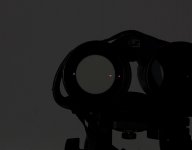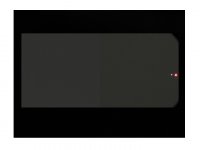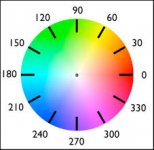-
Welcome to BirdForum, the internet's largest birding community with thousands of members from all over the world. The forums are dedicated to wild birds, birding, binoculars and equipment and all that goes with it.
Please register for an account to take part in the discussions in the forum, post your pictures in the gallery and more.
You are using an out of date browser. It may not display this or other websites correctly.
You should upgrade or use an alternative browser.
You should upgrade or use an alternative browser.
I do not like green cast and ham - 10x alpha redux (2 Viewers)
- Thread starter cyclist
- Start date
More options
Who Replied?Vespobuteo
Well-known member
OK, I just made more photos using the same northern skylight with an effort to improve the neutrality of the background. I don't remember what I did about white balance in the old ones, but this time I just set the camera white balance to auto. The background is white, underexposed to reduce it to a medium gray to increase color saturation. Unfortunately I don't have an SF or HT for comparison this time, so the 8x56 FL will have to stand alone. The crops show unaltered background color on the left, change in color from transiting the 8x56 FL on the right.
blue is still too high in the reference...(looking at RGB values)
so your FL is actually more neutral than the reference...
The left picture definitely has a green cast and in the right picture the left side is blue and the right side is green.OK, I just made more photos using the same northern skylight with an effort to improve the neutrality of the background. I don't remember what I did about white balance in the old ones, but this time I just set the camera white balance to auto. The background is white, underexposed to reduce it to a medium gray to increase color saturation. Unfortunately I don't have an SF or HT for comparison this time, so the 8x56 FL will have to stand alone. The crops show unaltered background color on the left, change in color from transiting the 8x56 FL on the right.
Vespobuteo
Well-known member
Looking at left pic I have no sense of hue. Looking at right pic, left side appears blue, right side green. However, looking at each side separately, the most striking difference (to me) is brightness, not hue.
I would say that the most striking is the lack of difference in brightness,
Luminance is pretty much the same...
Impressive transmission
Vespobuteo
Well-known member
The left picture definitely has a green cast and in the right picture the left side is blue and the right side is green.
looking at the RGB-values in the image file
the right side is the most neutral...
I think we can stop this endless "what color" do I see on MY monitor, guessing game
and move on to something more relevant.
"scientifically" people tend to like blue...so blue casts are probably preferred by many.
The sky is blue and so is my bins, but neutral, no...
https://today.yougov.com/news/2015/05/12/why-blue-worlds-favorite-color/
Last edited:
henry link
Well-known member
Nice pictures Henry and great effort. The left picture is green cast and on the right picture the right side is green cast. RGB values mean nothing. What the eye sees is what matters. You are using you eyes when you use your binoculars.
Last edited:
elkcub
Silicon Valley, California

Ed,
Thanks for presenting the article and your rather comprehensive synopsis of colour and perception, particularly as it relates to light spectra :t:
All I have to do now is figure out how all of that relates to my two different colour cast seeing eyes (one golden orangish, the other bluey-greenish), my transition lens eyeglasses and Mr Magoo-like myopia! |:d|
I do hope that Zeiss haven't messed with the HT formula, as that is one of the most neutral, nicely, realistically saturated, 'clarity' possessing views I have seen -- Zeiss could do worse than make the SF follow suit .....
Chosun :gh:
I wish people would stop thinking they can capture my reality on their film! :eek!:
This is really an intriguing set of observations. In all Henry's images the binocular part of the image is distinctly greener to my eyes than the background using three different screens. It's exactly as I would expect from Allbinis and Gijs' transmission profiles and tallies with my consistant experience of the FL, in particular, spanning several years and many different samples. Seems cut and dried to me, but there are too many reporting things differently to ignore.
Ever since I joined the forum there has been a debate over the colour cast of the FL. I remember different assertions that it it is neutral, blue, steely blue, green, yellow and even red. I've speculated that the deduced blue and red transmissions are a deliberate design characteristic as it appears to maintain contrast perception in extreme light conditions when perhaps the other alphas don't do so well. Whatever it is, it clearly divides opinion as it does with these photos.
I'm sure most are aware that a few percent of the population have one form of colour blindness or another. What is less well know is that the rest of the male population has one of two different mutations to one of the optical receptors. Roughly half will have the same form as the female population, the other half have a slightly different colour discrimination. Without a DNA test none of us are going to know for sure which one we have. All I know is my wife doesn't see the color difference in Henry's photos that I do. It's a long shot, but maybe I'm not the only one that doesn't see things the same way as their wife?
David
Ever since I joined the forum there has been a debate over the colour cast of the FL. I remember different assertions that it it is neutral, blue, steely blue, green, yellow and even red. I've speculated that the deduced blue and red transmissions are a deliberate design characteristic as it appears to maintain contrast perception in extreme light conditions when perhaps the other alphas don't do so well. Whatever it is, it clearly divides opinion as it does with these photos.
I'm sure most are aware that a few percent of the population have one form of colour blindness or another. What is less well know is that the rest of the male population has one of two different mutations to one of the optical receptors. Roughly half will have the same form as the female population, the other half have a slightly different colour discrimination. Without a DNA test none of us are going to know for sure which one we have. All I know is my wife doesn't see the color difference in Henry's photos that I do. It's a long shot, but maybe I'm not the only one that doesn't see things the same way as their wife?
David
My wife saw the green immediately just like I do. I am sure the green and red transmission curves of Zeiss and Leica's and Nikon's are a design characteristic to maintain contrast in extreme light condittions. Just like Cyclist said in low light conditions when there was a lot of green the Zeiss came alive and I am sure the red cast of Leica's and Nikon's would be beneficial under certain conditions just like the older Habicht's had a yellow cast for low light conditions. You personally have to decide if you want those added colors though and maybe in Ireland or the UK or Germany where there is a lot of green the Zeiss SF may be your binocular. The color cast under certain conditions may be beneficial and should not be looked at as a negative thing.This is really an intriguing set of observations. In all Henry's images the binocular part of the image is distinctly greener to my eyes than the background using three different screens. It's exactly as I would expect from Allbinis and Gijs' transmission profiles and tallies with my consistant experience of the FL, in particular, spanning several years and many different samples. Seems cut and dried to me, but there are too many reporting things differently to ignore.
Ever since I joined the forum there has been a debate over the colour cast of the FL. I remember different assertions that it it is neutral, blue, steely blue, green, yellow and even red. I've speculated that the deduced blue and red transmissions are a deliberate design characteristic as it appears to maintain contrast perception in extreme light conditions when perhaps the other alphas don't do so well. Whatever it is, it clearly divides opinion as it does with these photos.
I'm sure most are aware that a few percent of the population have one form of colour blindness or another. What is less well know is that the rest of the male population has one of two different mutations to one of the optical receptors. Roughly half will have the same form as the female population, the other half have a slightly different colour discrimination. Without a DNA test none of us are going to know for sure which one we have. All I know is my wife doesn't see the color difference in Henry's photos that I do. It's a long shot, but maybe I'm not the only one that doesn't see things the same way as their wife?
David
Last edited:
birdrousta
Well-known member
I wish people would stop thinking they can capture my reality on their film! :eek!:
As long as they tag it and release it again, your reality told me it was fine with it.
The film traps are apparently much more pleasant than some of the others.
Cycleguy, post 20,
I promised to come back to your question with regard to the color definition of the SLC and the Companion as compared with the EL. When I make an overlay of the transmission spectra of these binoculars, the color definition of all three looks pretty much the same.
Gijs van Ginkel
Thank you very much !!!!
Much appreciated,
CG
Alexis Powell
Natural history enthusiast

I'll echo a few who have already said as much by repeating that it is crazy to be arguing over what we can see in an image seen on our computer screens. Besides all the individual physiology variables and effects of light environment context, every monitor renders the underlying data differently. That said, reporting what we see would be a little less crazy if we all had properly profiled and calibrated monitors, but much to the dismay of us digital image editors, almost no one (except other serious digital image editors) does! For what it's worth, I have properly calibrated monitors and no form of color blindness. The bias toward green as compared to blue through the binoculars in Henry's original photos (and all the subsequent ones) is quite obvious to me. But as I noted before, it is ridiculous to argue over what we can see, so let me add some "objective" measures. In my academic research on color variation and its evolution in birds, I make use of a variety of digital image processing tools, so it is relatively easy for me to sample the pixels from digital images and convert them into various color spaces. jring has done well to point out the RGB values in the patches in Henry's post#14, but I'll go a step further by sampling nearly the entirety of each patch, then (approximately, given some commitments to standard illuminants etc) converting the average RGB values to the fairly popular HSV (Hue, Saturation, Value) color space.
Here are the RGB and HSV numbers for the patches from left to right:
patch, R_av, G_av, B_av, H, S, V
left (binocular), 89.6, 103.2, 116.7, 210, 23, 46
center (sky), 90.8, 104.7, 126.1, 216, 28, 49
right (binocular), 93.3, 106.8, 119.6, 209, 22, 47
As converted from the RGB values of Henry's images in post#14, the hues of the binocular views are 210 and 209 as compared to 216 for the sky sample. So yes, his sky-relative "white balance" is off and those numbers are all in the blue-cyan range (treating equal RGB values as neutral), but color comparisons are relative. The binocular hue of 209 or 210 is toward green as compared to the more blue sky hue of 216 (For reference, see attachment below of color wheel with hue degrees that I grabbed off the internet).
The color saturation of the sky is a little higher (28 versus 23 and 22), and it is brighter (49 versus 46 and 47) than the bins.
I've discussed all the above in a very sloppy way, but I hope this helps.
--AP
Here are the RGB and HSV numbers for the patches from left to right:
patch, R_av, G_av, B_av, H, S, V
left (binocular), 89.6, 103.2, 116.7, 210, 23, 46
center (sky), 90.8, 104.7, 126.1, 216, 28, 49
right (binocular), 93.3, 106.8, 119.6, 209, 22, 47
As converted from the RGB values of Henry's images in post#14, the hues of the binocular views are 210 and 209 as compared to 216 for the sky sample. So yes, his sky-relative "white balance" is off and those numbers are all in the blue-cyan range (treating equal RGB values as neutral), but color comparisons are relative. The binocular hue of 209 or 210 is toward green as compared to the more blue sky hue of 216 (For reference, see attachment below of color wheel with hue degrees that I grabbed off the internet).
The color saturation of the sky is a little higher (28 versus 23 and 22), and it is brighter (49 versus 46 and 47) than the bins.
I've discussed all the above in a very sloppy way, but I hope this helps.
--AP
Attachments
Thanks Alexis, I found that very helpful. I'd had a quick look for suitable tools to analyse the colours but found nothing much that did what I wanted... for free. 
If I understood it correctly we are arguing over a 6 or 7 point hue shift in the cyan. I'm just curious what a similar shift might look like around 530nm. Is it psssible to generate that?
The other interesting little detail I noted was the RGB numbers suggest the biggest difference between the areas is in the red, which might tie in with the trasmission spectrum. It's in the warm light of sunset where I'd noted that the FL appears most different from the more obvious alternatives.
David
If I understood it correctly we are arguing over a 6 or 7 point hue shift in the cyan. I'm just curious what a similar shift might look like around 530nm. Is it psssible to generate that?
The other interesting little detail I noted was the RGB numbers suggest the biggest difference between the areas is in the red, which might tie in with the trasmission spectrum. It's in the warm light of sunset where I'd noted that the FL appears most different from the more obvious alternatives.
David
Last edited:
Henry was just using other examples to display the greenish tint in Zeiss binoculars but Cyclist observed it in the SF. There are other documented examples of the greenish tint in the SF's. Tobias's excellent review displays the green color bias of the Zeiss SF and even explains why you may not notice the greenish tint when looking at something white like your "bleached calcium" beach you described. Here he quotes:
[/I][/B]
So don't you trust your own eyes now Dennis? You tried them out and looked for the green ghost and couldn't find it. Gijs can't find it in his measurements either. Also, see Elkclub's post 22 for cautions about comparisons.
Do some people see green? Yes. Do they vary in their descriptions? Yes. Do other people not see green? Yes. Did you see green? No.
Lee
What the eye sees is what matters. You are using you eyes when you use your binoculars.
Yes and you looked through SFs and declared that they don't have a green cast.
Lee
Last edited:
RGB values mean nothing. What the eye sees is what matters. You are using you eyes when you use your binoculars.
Dear Dennis
RGBs mean nothing?
The pictures that Henry took were captured by the camera as a set of RGB values, stored by his computer in a similar way, interpreted by your computer as a set of RGB values that your monitor did its best to display. Only then your eyes and brain did their thing.
Lee
Last edited:
It's a long shot, but maybe I'm not the only one that doesn't see things the same way as their wife?
David
This is true.
When it comes to the colour of textiles (we agree all the time about vegetation) me and Troubadoris regularly disagree about whether something is blue or green and yet we always agree about when sunlit seawater over white sand is transmitting turquoise.
These are not simple matters.
Lee
Users who are viewing this thread
Total: 3 (members: 0, guests: 3)






